Rosemary Cooke: A Character Analysis
VerifiedAdded on 2022/11/24
|7
|2220
|281
AI Summary
This article provides a detailed analysis of the character Rosemary Cooke from the novel 'We Are All Completely Beside Ourselves' by Karen Joy Fowler. It explores Rosemary's background, relationships, and personal growth throughout the story.
Contribute Materials
Your contribution can guide someone’s learning journey. Share your
documents today.
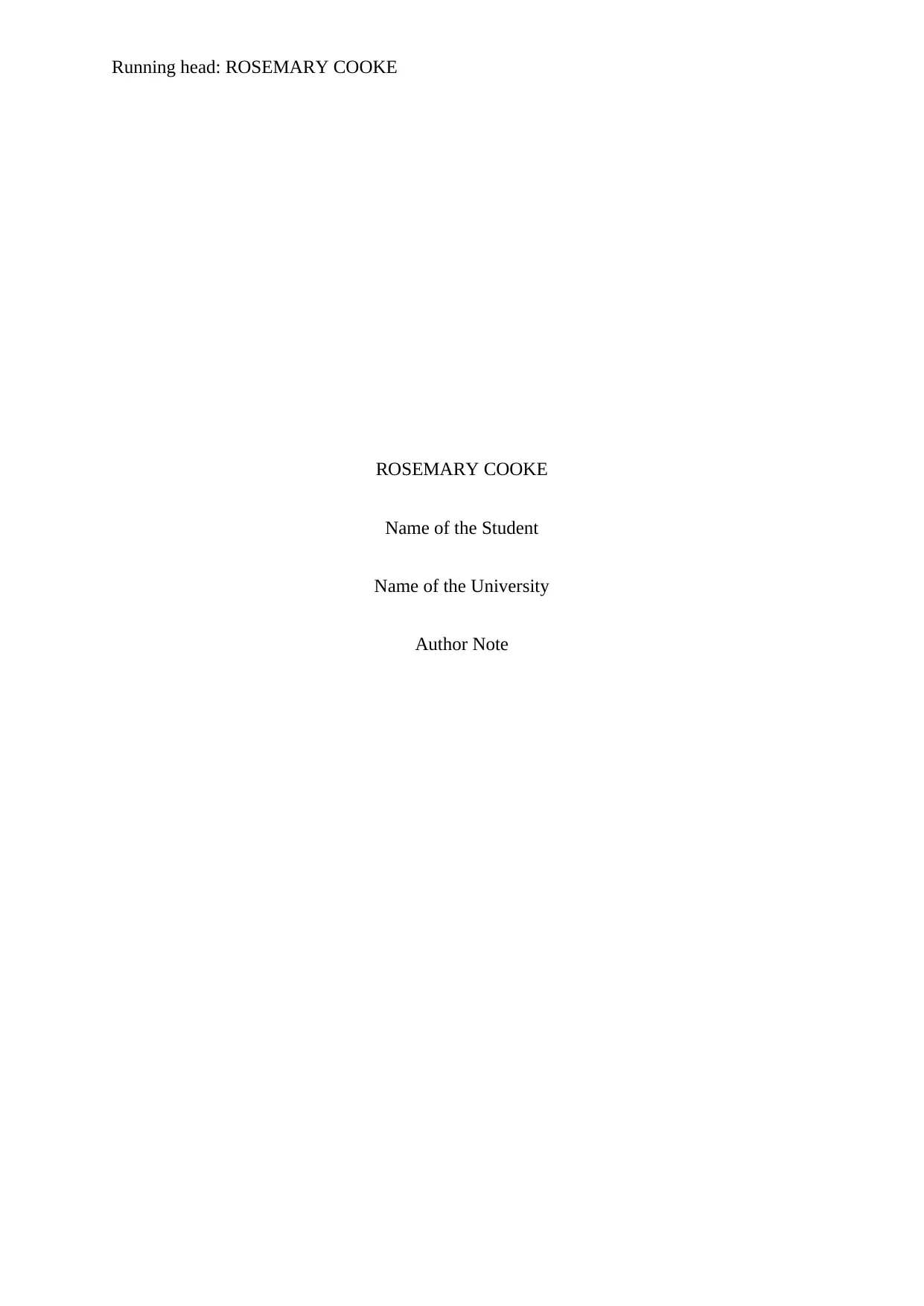
Running head: ROSEMARY COOKE
ROSEMARY COOKE
Name of the Student
Name of the University
Author Note
ROSEMARY COOKE
Name of the Student
Name of the University
Author Note
Secure Best Marks with AI Grader
Need help grading? Try our AI Grader for instant feedback on your assignments.
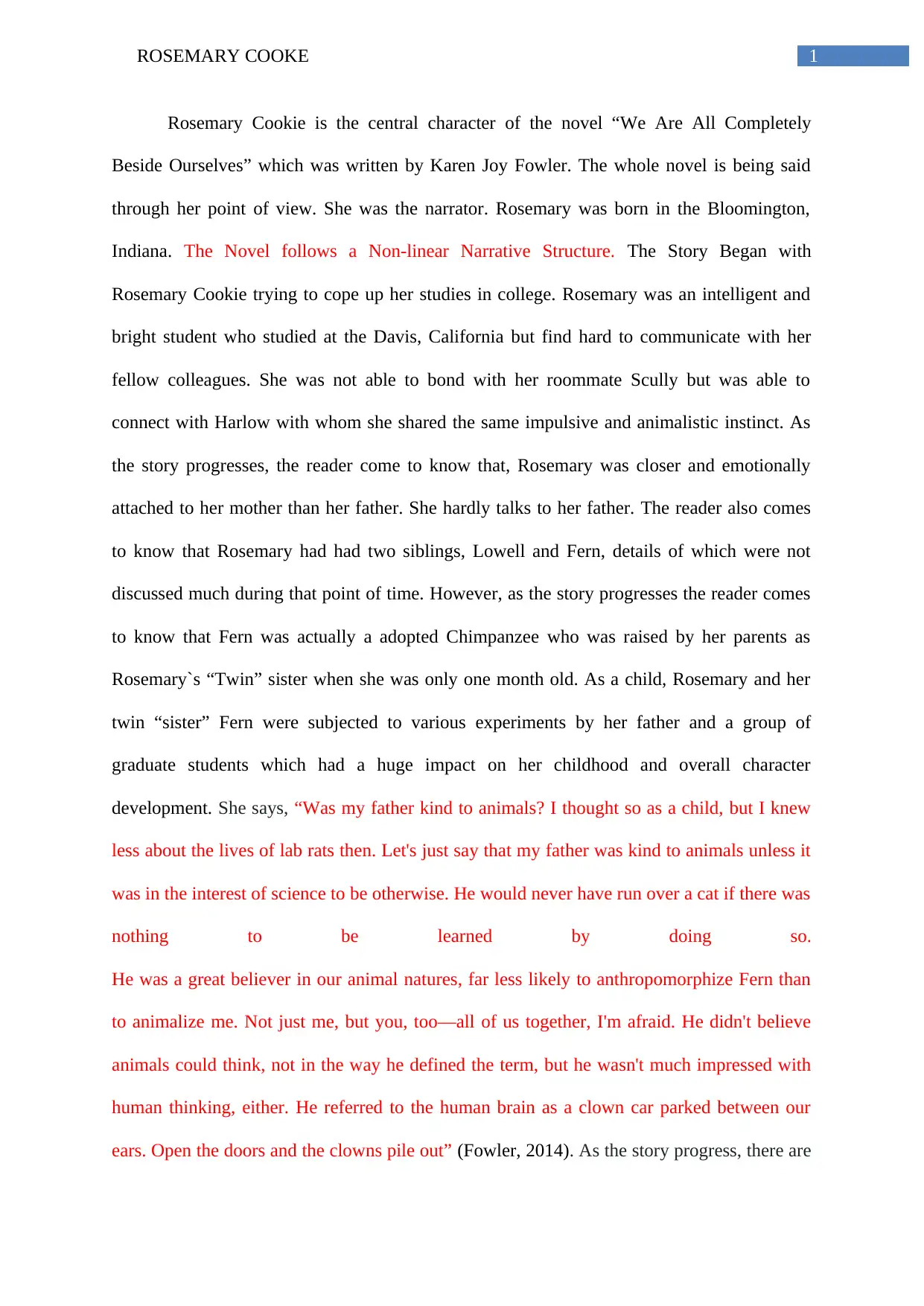
1ROSEMARY COOKE
Rosemary Cookie is the central character of the novel “We Are All Completely
Beside Ourselves” which was written by Karen Joy Fowler. The whole novel is being said
through her point of view. She was the narrator. Rosemary was born in the Bloomington,
Indiana. The Novel follows a Non-linear Narrative Structure. The Story Began with
Rosemary Cookie trying to cope up her studies in college. Rosemary was an intelligent and
bright student who studied at the Davis, California but find hard to communicate with her
fellow colleagues. She was not able to bond with her roommate Scully but was able to
connect with Harlow with whom she shared the same impulsive and animalistic instinct. As
the story progresses, the reader come to know that, Rosemary was closer and emotionally
attached to her mother than her father. She hardly talks to her father. The reader also comes
to know that Rosemary had had two siblings, Lowell and Fern, details of which were not
discussed much during that point of time. However, as the story progresses the reader comes
to know that Fern was actually a adopted Chimpanzee who was raised by her parents as
Rosemary`s “Twin” sister when she was only one month old. As a child, Rosemary and her
twin “sister” Fern were subjected to various experiments by her father and a group of
graduate students which had a huge impact on her childhood and overall character
development. She says, “Was my father kind to animals? I thought so as a child, but I knew
less about the lives of lab rats then. Let's just say that my father was kind to animals unless it
was in the interest of science to be otherwise. He would never have run over a cat if there was
nothing to be learned by doing so.
He was a great believer in our animal natures, far less likely to anthropomorphize Fern than
to animalize me. Not just me, but you, too––all of us together, I'm afraid. He didn't believe
animals could think, not in the way he defined the term, but he wasn't much impressed with
human thinking, either. He referred to the human brain as a clown car parked between our
ears. Open the doors and the clowns pile out” (Fowler, 2014). As the story progress, there are
Rosemary Cookie is the central character of the novel “We Are All Completely
Beside Ourselves” which was written by Karen Joy Fowler. The whole novel is being said
through her point of view. She was the narrator. Rosemary was born in the Bloomington,
Indiana. The Novel follows a Non-linear Narrative Structure. The Story Began with
Rosemary Cookie trying to cope up her studies in college. Rosemary was an intelligent and
bright student who studied at the Davis, California but find hard to communicate with her
fellow colleagues. She was not able to bond with her roommate Scully but was able to
connect with Harlow with whom she shared the same impulsive and animalistic instinct. As
the story progresses, the reader come to know that, Rosemary was closer and emotionally
attached to her mother than her father. She hardly talks to her father. The reader also comes
to know that Rosemary had had two siblings, Lowell and Fern, details of which were not
discussed much during that point of time. However, as the story progresses the reader comes
to know that Fern was actually a adopted Chimpanzee who was raised by her parents as
Rosemary`s “Twin” sister when she was only one month old. As a child, Rosemary and her
twin “sister” Fern were subjected to various experiments by her father and a group of
graduate students which had a huge impact on her childhood and overall character
development. She says, “Was my father kind to animals? I thought so as a child, but I knew
less about the lives of lab rats then. Let's just say that my father was kind to animals unless it
was in the interest of science to be otherwise. He would never have run over a cat if there was
nothing to be learned by doing so.
He was a great believer in our animal natures, far less likely to anthropomorphize Fern than
to animalize me. Not just me, but you, too––all of us together, I'm afraid. He didn't believe
animals could think, not in the way he defined the term, but he wasn't much impressed with
human thinking, either. He referred to the human brain as a clown car parked between our
ears. Open the doors and the clowns pile out” (Fowler, 2014). As the story progress, there are
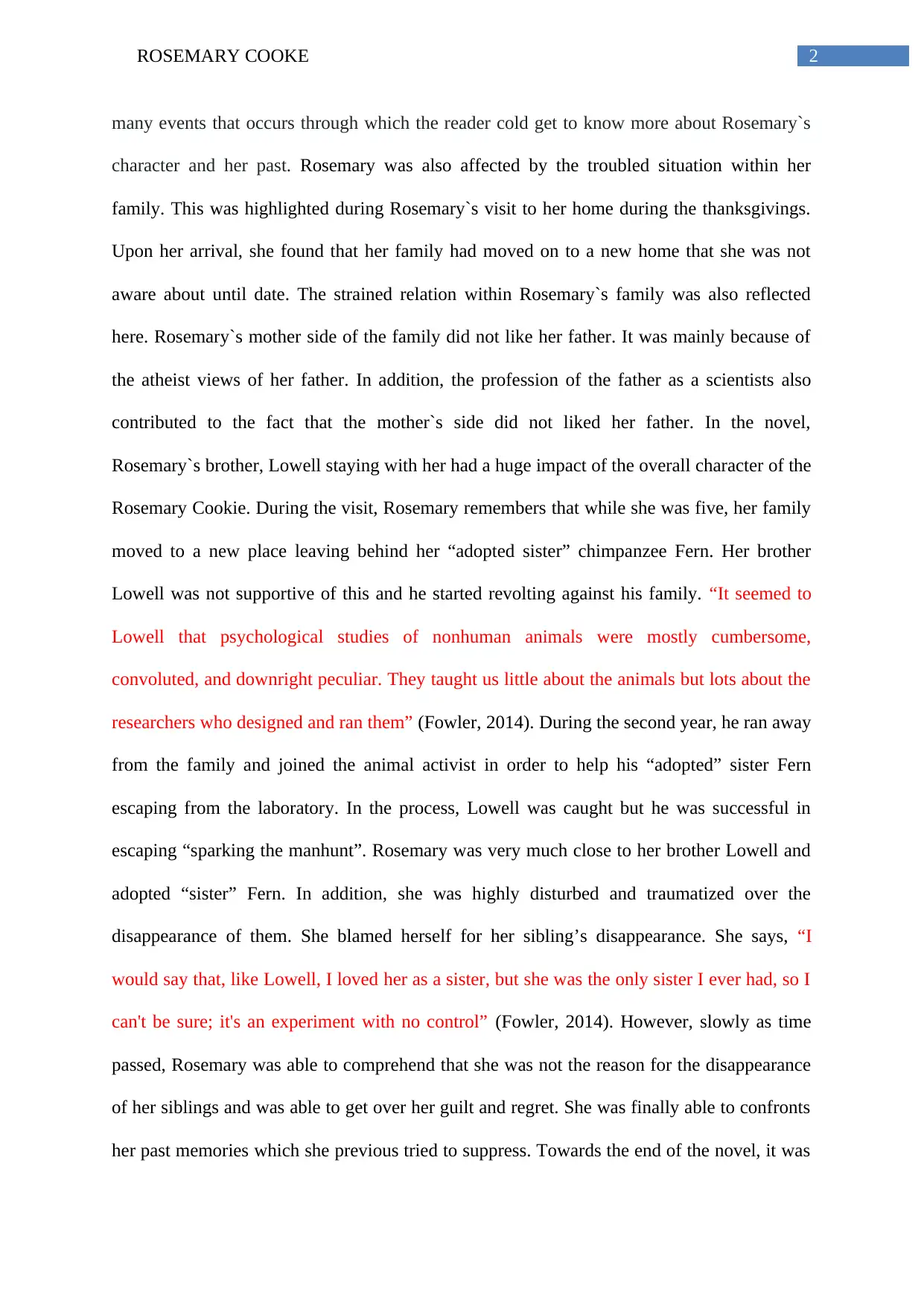
2ROSEMARY COOKE
many events that occurs through which the reader cold get to know more about Rosemary`s
character and her past. Rosemary was also affected by the troubled situation within her
family. This was highlighted during Rosemary`s visit to her home during the thanksgivings.
Upon her arrival, she found that her family had moved on to a new home that she was not
aware about until date. The strained relation within Rosemary`s family was also reflected
here. Rosemary`s mother side of the family did not like her father. It was mainly because of
the atheist views of her father. In addition, the profession of the father as a scientists also
contributed to the fact that the mother`s side did not liked her father. In the novel,
Rosemary`s brother, Lowell staying with her had a huge impact of the overall character of the
Rosemary Cookie. During the visit, Rosemary remembers that while she was five, her family
moved to a new place leaving behind her “adopted sister” chimpanzee Fern. Her brother
Lowell was not supportive of this and he started revolting against his family. “It seemed to
Lowell that psychological studies of nonhuman animals were mostly cumbersome,
convoluted, and downright peculiar. They taught us little about the animals but lots about the
researchers who designed and ran them” (Fowler, 2014). During the second year, he ran away
from the family and joined the animal activist in order to help his “adopted” sister Fern
escaping from the laboratory. In the process, Lowell was caught but he was successful in
escaping “sparking the manhunt”. Rosemary was very much close to her brother Lowell and
adopted “sister” Fern. In addition, she was highly disturbed and traumatized over the
disappearance of them. She blamed herself for her sibling’s disappearance. She says, “I
would say that, like Lowell, I loved her as a sister, but she was the only sister I ever had, so I
can't be sure; it's an experiment with no control” (Fowler, 2014). However, slowly as time
passed, Rosemary was able to comprehend that she was not the reason for the disappearance
of her siblings and was able to get over her guilt and regret. She was finally able to confronts
her past memories which she previous tried to suppress. Towards the end of the novel, it was
many events that occurs through which the reader cold get to know more about Rosemary`s
character and her past. Rosemary was also affected by the troubled situation within her
family. This was highlighted during Rosemary`s visit to her home during the thanksgivings.
Upon her arrival, she found that her family had moved on to a new home that she was not
aware about until date. The strained relation within Rosemary`s family was also reflected
here. Rosemary`s mother side of the family did not like her father. It was mainly because of
the atheist views of her father. In addition, the profession of the father as a scientists also
contributed to the fact that the mother`s side did not liked her father. In the novel,
Rosemary`s brother, Lowell staying with her had a huge impact of the overall character of the
Rosemary Cookie. During the visit, Rosemary remembers that while she was five, her family
moved to a new place leaving behind her “adopted sister” chimpanzee Fern. Her brother
Lowell was not supportive of this and he started revolting against his family. “It seemed to
Lowell that psychological studies of nonhuman animals were mostly cumbersome,
convoluted, and downright peculiar. They taught us little about the animals but lots about the
researchers who designed and ran them” (Fowler, 2014). During the second year, he ran away
from the family and joined the animal activist in order to help his “adopted” sister Fern
escaping from the laboratory. In the process, Lowell was caught but he was successful in
escaping “sparking the manhunt”. Rosemary was very much close to her brother Lowell and
adopted “sister” Fern. In addition, she was highly disturbed and traumatized over the
disappearance of them. She blamed herself for her sibling’s disappearance. She says, “I
would say that, like Lowell, I loved her as a sister, but she was the only sister I ever had, so I
can't be sure; it's an experiment with no control” (Fowler, 2014). However, slowly as time
passed, Rosemary was able to comprehend that she was not the reason for the disappearance
of her siblings and was able to get over her guilt and regret. She was finally able to confronts
her past memories which she previous tried to suppress. Towards the end of the novel, it was
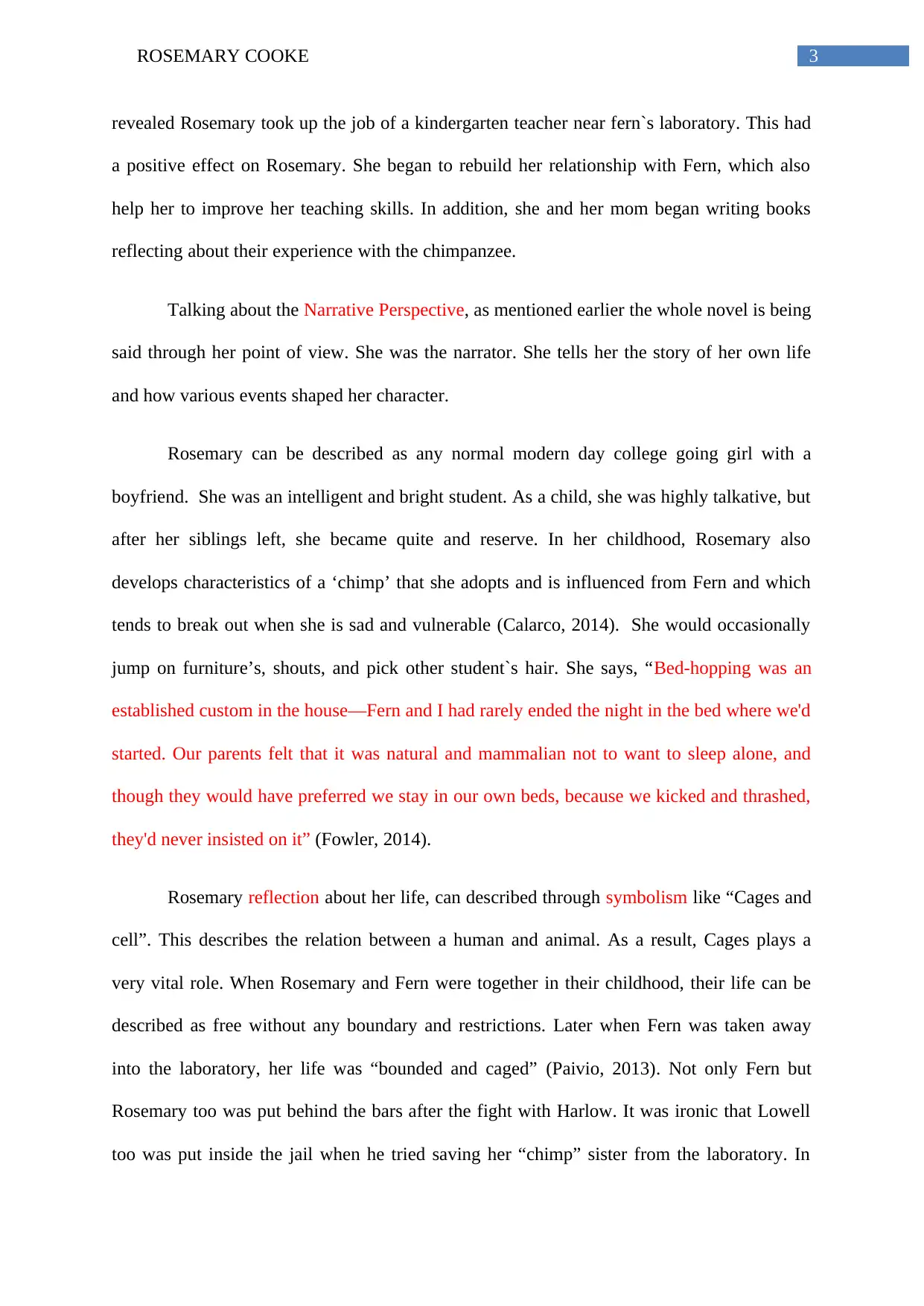
3ROSEMARY COOKE
revealed Rosemary took up the job of a kindergarten teacher near fern`s laboratory. This had
a positive effect on Rosemary. She began to rebuild her relationship with Fern, which also
help her to improve her teaching skills. In addition, she and her mom began writing books
reflecting about their experience with the chimpanzee.
Talking about the Narrative Perspective, as mentioned earlier the whole novel is being
said through her point of view. She was the narrator. She tells her the story of her own life
and how various events shaped her character.
Rosemary can be described as any normal modern day college going girl with a
boyfriend. She was an intelligent and bright student. As a child, she was highly talkative, but
after her siblings left, she became quite and reserve. In her childhood, Rosemary also
develops characteristics of a ‘chimp’ that she adopts and is influenced from Fern and which
tends to break out when she is sad and vulnerable (Calarco, 2014). She would occasionally
jump on furniture’s, shouts, and pick other student`s hair. She says, “Bed-hopping was an
established custom in the house—Fern and I had rarely ended the night in the bed where we'd
started. Our parents felt that it was natural and mammalian not to want to sleep alone, and
though they would have preferred we stay in our own beds, because we kicked and thrashed,
they'd never insisted on it” (Fowler, 2014).
Rosemary reflection about her life, can described through symbolism like “Cages and
cell”. This describes the relation between a human and animal. As a result, Cages plays a
very vital role. When Rosemary and Fern were together in their childhood, their life can be
described as free without any boundary and restrictions. Later when Fern was taken away
into the laboratory, her life was “bounded and caged” (Paivio, 2013). Not only Fern but
Rosemary too was put behind the bars after the fight with Harlow. It was ironic that Lowell
too was put inside the jail when he tried saving her “chimp” sister from the laboratory. In
revealed Rosemary took up the job of a kindergarten teacher near fern`s laboratory. This had
a positive effect on Rosemary. She began to rebuild her relationship with Fern, which also
help her to improve her teaching skills. In addition, she and her mom began writing books
reflecting about their experience with the chimpanzee.
Talking about the Narrative Perspective, as mentioned earlier the whole novel is being
said through her point of view. She was the narrator. She tells her the story of her own life
and how various events shaped her character.
Rosemary can be described as any normal modern day college going girl with a
boyfriend. She was an intelligent and bright student. As a child, she was highly talkative, but
after her siblings left, she became quite and reserve. In her childhood, Rosemary also
develops characteristics of a ‘chimp’ that she adopts and is influenced from Fern and which
tends to break out when she is sad and vulnerable (Calarco, 2014). She would occasionally
jump on furniture’s, shouts, and pick other student`s hair. She says, “Bed-hopping was an
established custom in the house—Fern and I had rarely ended the night in the bed where we'd
started. Our parents felt that it was natural and mammalian not to want to sleep alone, and
though they would have preferred we stay in our own beds, because we kicked and thrashed,
they'd never insisted on it” (Fowler, 2014).
Rosemary reflection about her life, can described through symbolism like “Cages and
cell”. This describes the relation between a human and animal. As a result, Cages plays a
very vital role. When Rosemary and Fern were together in their childhood, their life can be
described as free without any boundary and restrictions. Later when Fern was taken away
into the laboratory, her life was “bounded and caged” (Paivio, 2013). Not only Fern but
Rosemary too was put behind the bars after the fight with Harlow. It was ironic that Lowell
too was put inside the jail when he tried saving her “chimp” sister from the laboratory. In
Secure Best Marks with AI Grader
Need help grading? Try our AI Grader for instant feedback on your assignments.
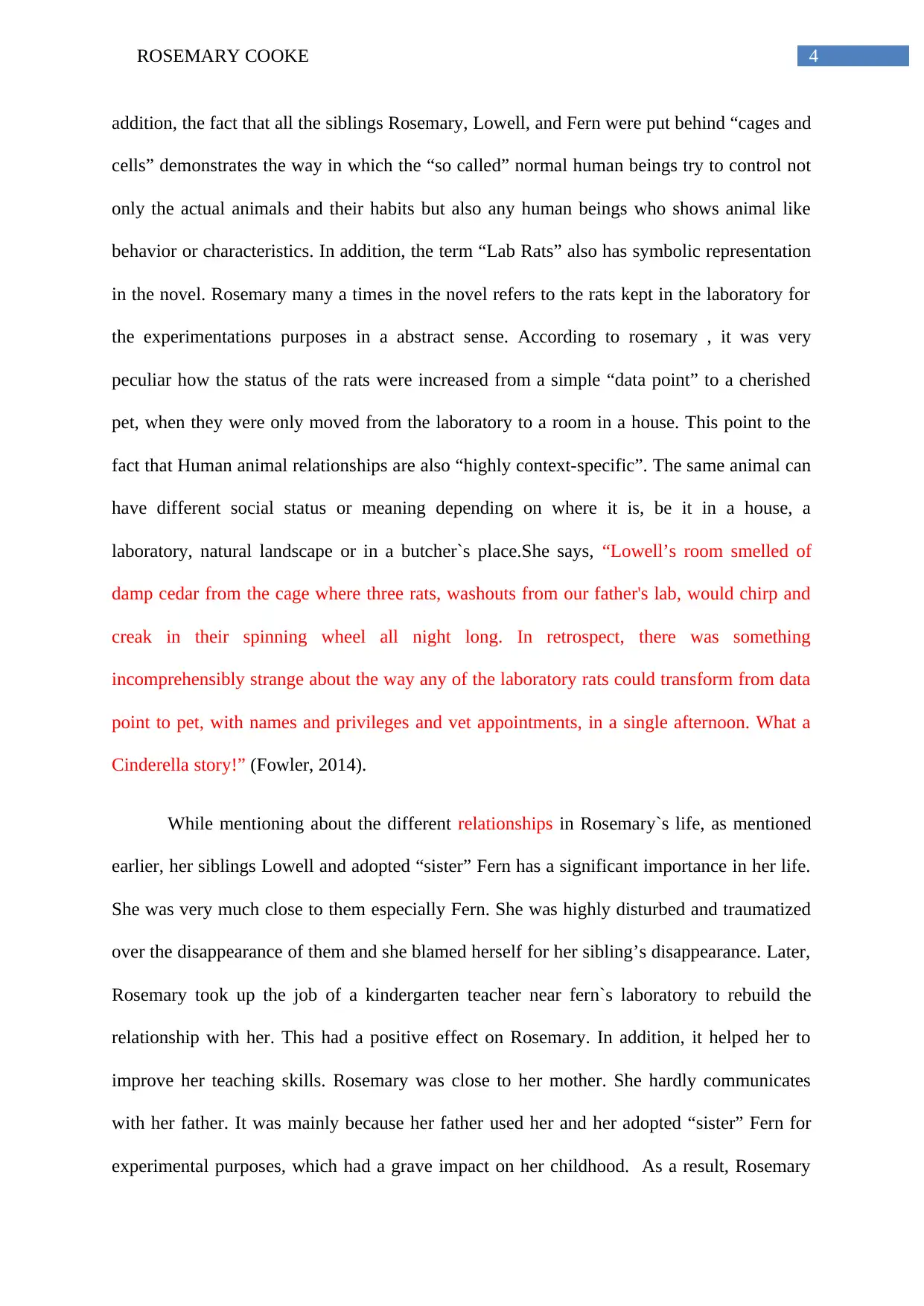
4ROSEMARY COOKE
addition, the fact that all the siblings Rosemary, Lowell, and Fern were put behind “cages and
cells” demonstrates the way in which the “so called” normal human beings try to control not
only the actual animals and their habits but also any human beings who shows animal like
behavior or characteristics. In addition, the term “Lab Rats” also has symbolic representation
in the novel. Rosemary many a times in the novel refers to the rats kept in the laboratory for
the experimentations purposes in a abstract sense. According to rosemary , it was very
peculiar how the status of the rats were increased from a simple “data point” to a cherished
pet, when they were only moved from the laboratory to a room in a house. This point to the
fact that Human animal relationships are also “highly context-specific”. The same animal can
have different social status or meaning depending on where it is, be it in a house, a
laboratory, natural landscape or in a butcher`s place.She says, “Lowell’s room smelled of
damp cedar from the cage where three rats, washouts from our father's lab, would chirp and
creak in their spinning wheel all night long. In retrospect, there was something
incomprehensibly strange about the way any of the laboratory rats could transform from data
point to pet, with names and privileges and vet appointments, in a single afternoon. What a
Cinderella story!” (Fowler, 2014).
While mentioning about the different relationships in Rosemary`s life, as mentioned
earlier, her siblings Lowell and adopted “sister” Fern has a significant importance in her life.
She was very much close to them especially Fern. She was highly disturbed and traumatized
over the disappearance of them and she blamed herself for her sibling’s disappearance. Later,
Rosemary took up the job of a kindergarten teacher near fern`s laboratory to rebuild the
relationship with her. This had a positive effect on Rosemary. In addition, it helped her to
improve her teaching skills. Rosemary was close to her mother. She hardly communicates
with her father. It was mainly because her father used her and her adopted “sister” Fern for
experimental purposes, which had a grave impact on her childhood. As a result, Rosemary
addition, the fact that all the siblings Rosemary, Lowell, and Fern were put behind “cages and
cells” demonstrates the way in which the “so called” normal human beings try to control not
only the actual animals and their habits but also any human beings who shows animal like
behavior or characteristics. In addition, the term “Lab Rats” also has symbolic representation
in the novel. Rosemary many a times in the novel refers to the rats kept in the laboratory for
the experimentations purposes in a abstract sense. According to rosemary , it was very
peculiar how the status of the rats were increased from a simple “data point” to a cherished
pet, when they were only moved from the laboratory to a room in a house. This point to the
fact that Human animal relationships are also “highly context-specific”. The same animal can
have different social status or meaning depending on where it is, be it in a house, a
laboratory, natural landscape or in a butcher`s place.She says, “Lowell’s room smelled of
damp cedar from the cage where three rats, washouts from our father's lab, would chirp and
creak in their spinning wheel all night long. In retrospect, there was something
incomprehensibly strange about the way any of the laboratory rats could transform from data
point to pet, with names and privileges and vet appointments, in a single afternoon. What a
Cinderella story!” (Fowler, 2014).
While mentioning about the different relationships in Rosemary`s life, as mentioned
earlier, her siblings Lowell and adopted “sister” Fern has a significant importance in her life.
She was very much close to them especially Fern. She was highly disturbed and traumatized
over the disappearance of them and she blamed herself for her sibling’s disappearance. Later,
Rosemary took up the job of a kindergarten teacher near fern`s laboratory to rebuild the
relationship with her. This had a positive effect on Rosemary. In addition, it helped her to
improve her teaching skills. Rosemary was close to her mother. She hardly communicates
with her father. It was mainly because her father used her and her adopted “sister” Fern for
experimental purposes, which had a grave impact on her childhood. As a result, Rosemary
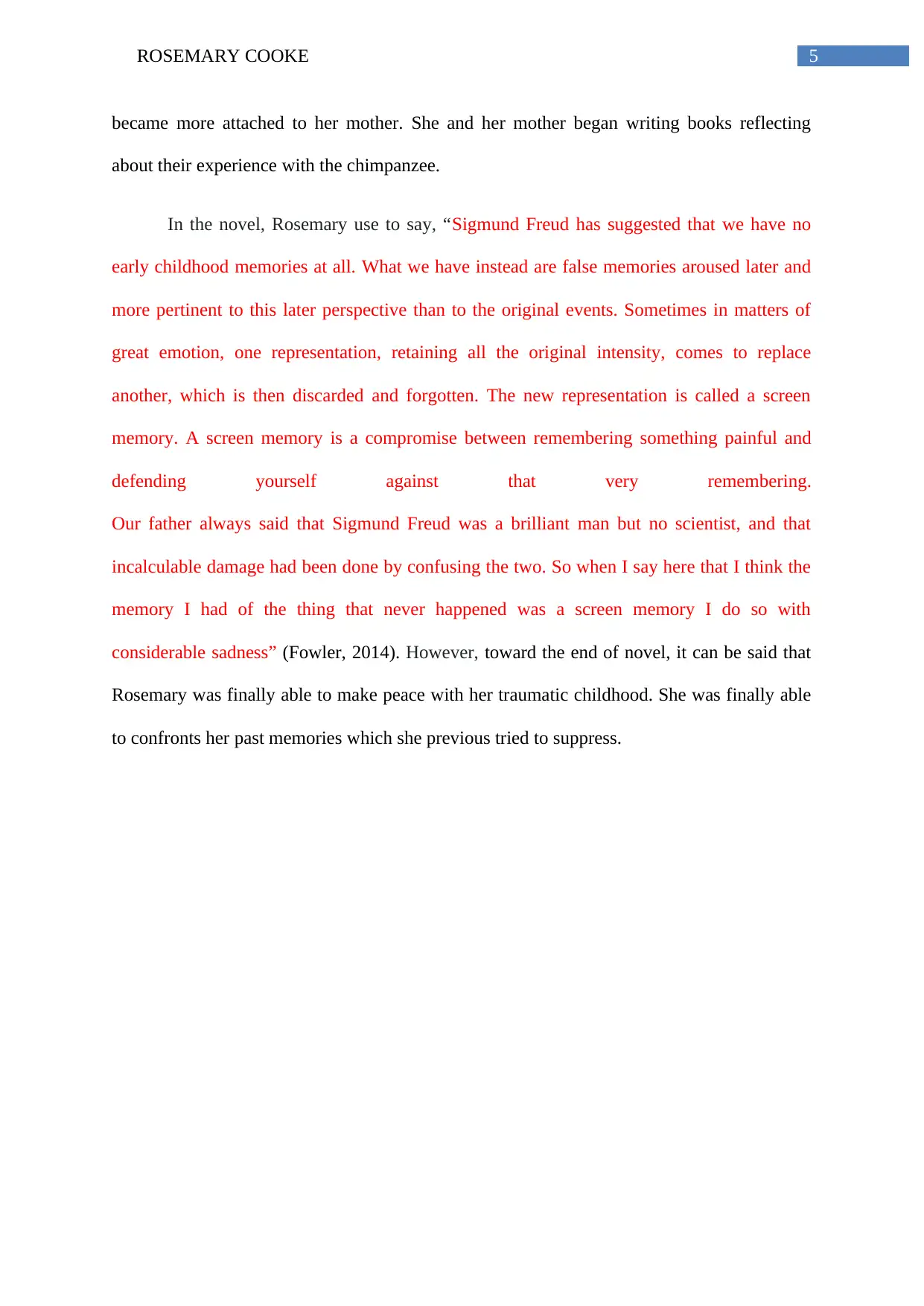
5ROSEMARY COOKE
became more attached to her mother. She and her mother began writing books reflecting
about their experience with the chimpanzee.
In the novel, Rosemary use to say, “Sigmund Freud has suggested that we have no
early childhood memories at all. What we have instead are false memories aroused later and
more pertinent to this later perspective than to the original events. Sometimes in matters of
great emotion, one representation, retaining all the original intensity, comes to replace
another, which is then discarded and forgotten. The new representation is called a screen
memory. A screen memory is a compromise between remembering something painful and
defending yourself against that very remembering.
Our father always said that Sigmund Freud was a brilliant man but no scientist, and that
incalculable damage had been done by confusing the two. So when I say here that I think the
memory I had of the thing that never happened was a screen memory I do so with
considerable sadness” (Fowler, 2014). However, toward the end of novel, it can be said that
Rosemary was finally able to make peace with her traumatic childhood. She was finally able
to confronts her past memories which she previous tried to suppress.
became more attached to her mother. She and her mother began writing books reflecting
about their experience with the chimpanzee.
In the novel, Rosemary use to say, “Sigmund Freud has suggested that we have no
early childhood memories at all. What we have instead are false memories aroused later and
more pertinent to this later perspective than to the original events. Sometimes in matters of
great emotion, one representation, retaining all the original intensity, comes to replace
another, which is then discarded and forgotten. The new representation is called a screen
memory. A screen memory is a compromise between remembering something painful and
defending yourself against that very remembering.
Our father always said that Sigmund Freud was a brilliant man but no scientist, and that
incalculable damage had been done by confusing the two. So when I say here that I think the
memory I had of the thing that never happened was a screen memory I do so with
considerable sadness” (Fowler, 2014). However, toward the end of novel, it can be said that
Rosemary was finally able to make peace with her traumatic childhood. She was finally able
to confronts her past memories which she previous tried to suppress.
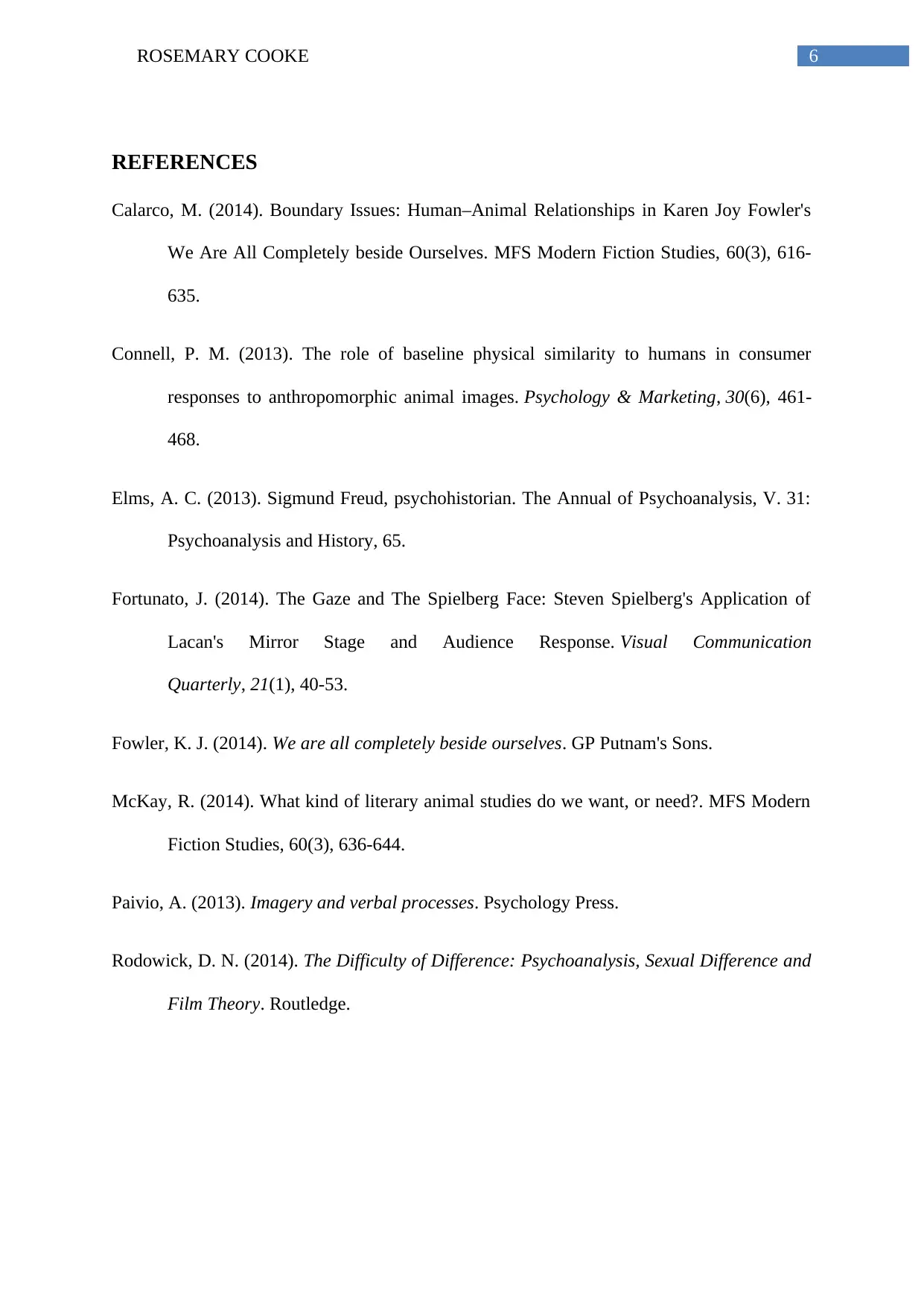
6ROSEMARY COOKE
REFERENCES
Calarco, M. (2014). Boundary Issues: Human–Animal Relationships in Karen Joy Fowler's
We Are All Completely beside Ourselves. MFS Modern Fiction Studies, 60(3), 616-
635.
Connell, P. M. (2013). The role of baseline physical similarity to humans in consumer
responses to anthropomorphic animal images. Psychology & Marketing, 30(6), 461-
468.
Elms, A. C. (2013). Sigmund Freud, psychohistorian. The Annual of Psychoanalysis, V. 31:
Psychoanalysis and History, 65.
Fortunato, J. (2014). The Gaze and The Spielberg Face: Steven Spielberg's Application of
Lacan's Mirror Stage and Audience Response. Visual Communication
Quarterly, 21(1), 40-53.
Fowler, K. J. (2014). We are all completely beside ourselves. GP Putnam's Sons.
McKay, R. (2014). What kind of literary animal studies do we want, or need?. MFS Modern
Fiction Studies, 60(3), 636-644.
Paivio, A. (2013). Imagery and verbal processes. Psychology Press.
Rodowick, D. N. (2014). The Difficulty of Difference: Psychoanalysis, Sexual Difference and
Film Theory. Routledge.
REFERENCES
Calarco, M. (2014). Boundary Issues: Human–Animal Relationships in Karen Joy Fowler's
We Are All Completely beside Ourselves. MFS Modern Fiction Studies, 60(3), 616-
635.
Connell, P. M. (2013). The role of baseline physical similarity to humans in consumer
responses to anthropomorphic animal images. Psychology & Marketing, 30(6), 461-
468.
Elms, A. C. (2013). Sigmund Freud, psychohistorian. The Annual of Psychoanalysis, V. 31:
Psychoanalysis and History, 65.
Fortunato, J. (2014). The Gaze and The Spielberg Face: Steven Spielberg's Application of
Lacan's Mirror Stage and Audience Response. Visual Communication
Quarterly, 21(1), 40-53.
Fowler, K. J. (2014). We are all completely beside ourselves. GP Putnam's Sons.
McKay, R. (2014). What kind of literary animal studies do we want, or need?. MFS Modern
Fiction Studies, 60(3), 636-644.
Paivio, A. (2013). Imagery and verbal processes. Psychology Press.
Rodowick, D. N. (2014). The Difficulty of Difference: Psychoanalysis, Sexual Difference and
Film Theory. Routledge.
1 out of 7
Related Documents
Your All-in-One AI-Powered Toolkit for Academic Success.
+13062052269
info@desklib.com
Available 24*7 on WhatsApp / Email
![[object Object]](/_next/static/media/star-bottom.7253800d.svg)
Unlock your academic potential
© 2024 | Zucol Services PVT LTD | All rights reserved.





